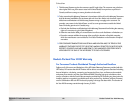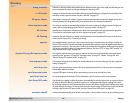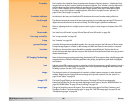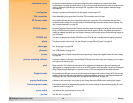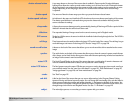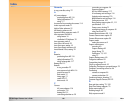
HP 912 Digital Camera User’s Guide 129 Glossary
image type button
A status LCD button on the top of the camera that you press to select the image type.
image type icon
An icon that appears in the status LCD and shows the image type setting.
infrared
A type of connection that allows images to be transmitted between the camera and another device (such
as a printer) without connecting wires when the infrared window on the camera is lined-up with an infrared
sensor on the other device. See also “JetSend” on page 129.
infrared window
The window on the front of the camera that uses the HP JetSend infrared technology. See also “JetSend”
on page 129.
interval
The time between images being captured for the Timelapse image type.
ISO number
The International Organization for Standardization rating for film or CCD sensitivity. A higher ISO number
means less light is needed to take a picture. CCDs in digital cameras are rated in terms of ISO numbers.
ISO is not an acronym; it is derived from the Greek “isos”, meaning equal. See also “CCD” on page 126.
JetSend
A protocol developed by HP for sending image data from one device to another without using any
connecting cables between the devices. HP JetSend uses infrared technology to transmit images from the
camera to a printer for printing.
JPEG
A compressed image file format developed by the Joint Photo Expert Group. Its strengths are very small
file sizes and fast display rates. (It is 7 to 10 times faster than some other image file formats.) See also “file
type” on page 127 and “TIFF” on page 134.
Landscape exposure mode
The exposure mode that automatically optimizes the camera settings for taking pictures of distant
subjects, such as landscape scenes. See also “exposure modes” on page 127.
LCD
Liquid Crystal Display. A display technology that is used on digital cameras. An LCD displays numeric
characters and/or icons to communicate the camera's status, such as the particular settings that you have
made for taking a picture. See also “image LCD” on page 128 and “status LCD” on page 133.
LED
Light Emitting Diode. An indicator on the camera that shows the status of some feature or process by
either lighting solid or blinking on and off.
lens
One or more pieces of optical glass or similar material designed to collect and focus rays of light to form
a sharp image on the film (for traditional film cameras) or the CCD (for digital cameras). Lenses are rated
according to their maximum aperture (smallest possible f-number) and their focal length (usually
specified in millimeters). See also “aperture” on page 125, “CCD” on page 126, and “f-number” on
page 128.
lithium ion (Li-Ion) battery pack
An optional battery that you can use in the camera, which you can recharge and re-use.
live view
Using the image LCD on the back of the camera to view the picture subject before taking the picture.
Manual exposure mode
The exposure mode in which you have complete control over shutter speed, aperture, and all other
camera settings. A fixed tone curve is used to adjust exposure. See also “exposure modes” on page 127.




